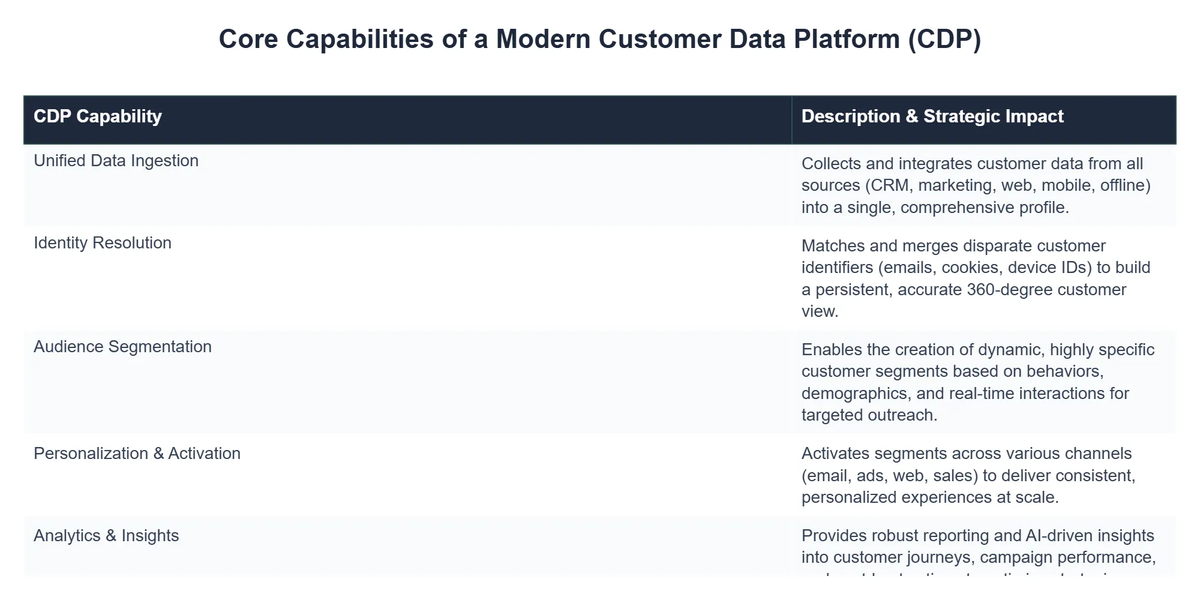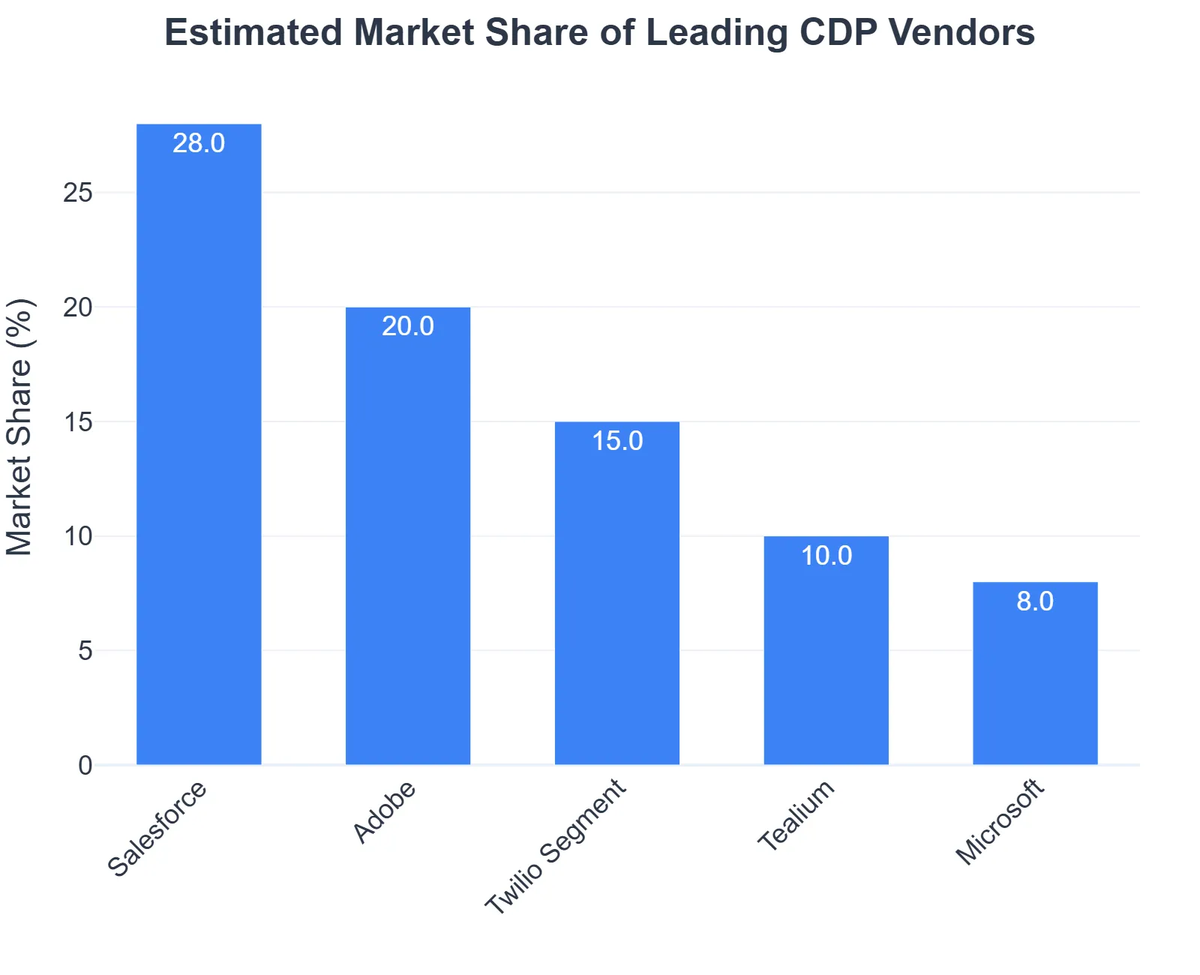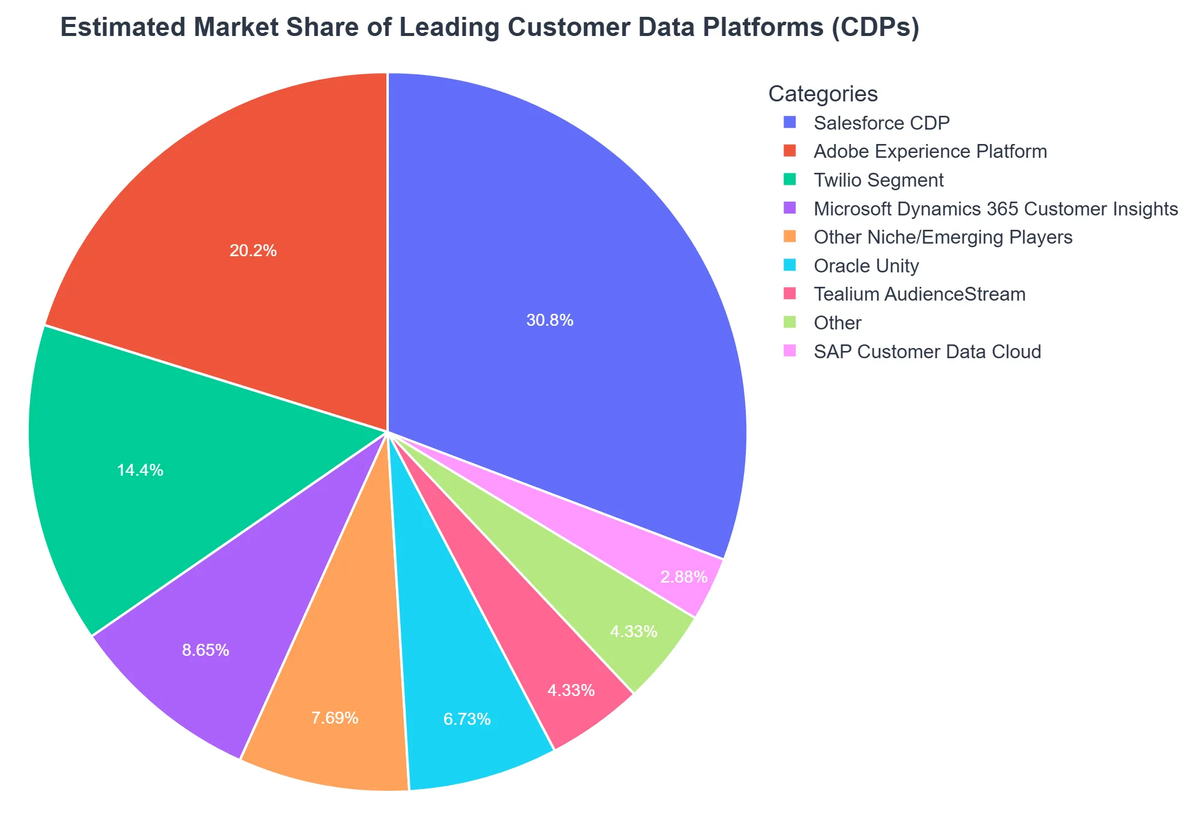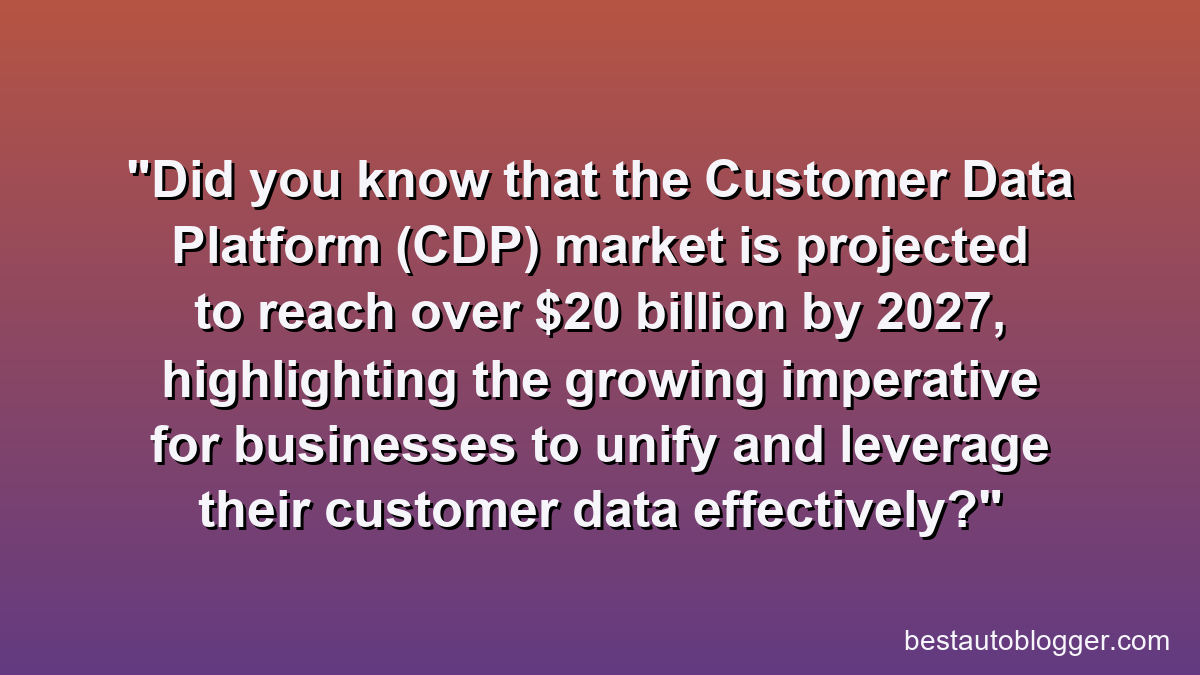In today’s hyper-competitive digital landscape, understanding your customer is no longer a luxury—it’s a fundamental requirement for survival and growth. Businesses are awash in data, from website clicks and email opens to purchase history and customer service interactions. The challenge isn’t data collection, but rather data orchestration and activation. This is precisely where a customer data management platform (CDP) becomes indispensable.
💡 Key Takeaways
- Understand what a Customer Data Platform (CDP) is and its core functionalities.
- Explore how Salesforce plays a role in the CDP ecosystem and data unification.
- Learn about the broader CDP landscape beyond Salesforce and key players in the market.
- Discover the critical benefits of leveraging a CDP for enhanced customer insights and personalized engagement.
“Implementing a CDP, especially when layered strategically with a powerful CRM like Salesforce, is truly transformative. It moves organizations from siloed data to actionable, unified customer profiles, enabling hyper-personalization at scale.”
— Michael Adams, CRM & Automation Implementation Lead
A CDP acts as a central nervous system for all your customer information, unifying disparate data sources into a single, comprehensive customer profile. While many marketing and sales technologies touch customer data, CDPs provide a unique, persistent, and unified view, enabling truly personalized experiences and informed strategic decisions. This guide will explore the power of Customer Data Platforms, delve into how a platform like Salesforce Data Cloud leads the charge, and look at the broader landscape of this transformative technology.
In This Article
- — 💡 Key Takeaways
- → What is a Customer Data Platform (CDP)?
- — ➡️ Beyond CRM & DMP
- — 💡 Key Capabilities of a CDP
- → Why Your Business Needs a CDP in the Modern Era
- — 📊 Unified Customer View
- — ✨ Enhanced Personalization & CX
- — 🔒 Data Compliance & Governance
- → Salesforce Data Cloud: A Deep Dive
- — evolution-from-salesforce-cdp”>➡️ Evolution from Salesforce CDP
- — ⚙️ Core Features & Benefits of Salesforce Data Cloud
- — 🔗 How it Integrates with Salesforce Ecosystem
- → Beyond Salesforce: Other Leading CDP Solutions
- → Implementing a CDP: Best Practices & Considerations
- — 🗺️ Defining Your Data Strategy
- — 🤝 Integration Challenges & Solutions
- — 📈 Measuring ROI
- → The Future of Customer Data Management
- — 🤖 AI & Machine Learning’s Role
- — 🛡️ Privacy-First Approaches
- → Conclusion
What is a Customer Data Platform (CDP)?
A Customer Data Platform (CDP) is a packaged software that creates a persistent, unified customer database that is accessible to other systems. It collects and unifies customer data from various sources (online, offline, transactional, behavioral, demographic) to create a single, comprehensive profile for each individual customer.

➡️ Beyond CRM & DMP
While often confused with other systems, a CDP has distinct characteristics:
- ✅ CRM (Customer Relationship Management): CRMs primarily manage interactions with existing customers and prospects for sales and service. They focus on managing relationships. A CDP, conversely, aggregates and unifies data across all sources, not just sales and service interactions, providing a deeper, more holistic view.
- ✅ DMP (Data Management Platform): DMPs primarily deal with anonymous, cookie-based data for advertising targeting and segmentation, often for short-term campaigns. They are focused on audiences, not individual customer profiles. CDPs, on the other hand, build persistent, identifiable profiles and are designed for both known and unknown customers, enabling personalized experiences across all channels.
A CDP bridges the gap, providing the foundational data layer that empowers both CRM and marketing automation systems to perform at their peak. For a broader understanding of how these systems integrate, consider our comprehensive resource: CRM & Marketing Automation: The Ultimate Guide.
💡 Key Capabilities of a CDP
At its core, a robust customer data platform salesforce or any other leading CDP offers:

- ✅ Data Ingestion & Unification: Gathers data from diverse sources (web, mobile apps, CRM, ERP, PoS, social media, IoT devices) and stitches it together into a single, unified customer view.
- ✅ Profile Creation: Builds persistent, comprehensive profiles for each individual customer, linking all their interactions and attributes.
- ✅ Segmentation: Allows marketers to create precise customer segments based on rich behavioral, demographic, and transactional data. This is crucial for effective targeting, as explored in our guide on Automated Customer Segmentation Software.
- ✅ Activation: Connects with other marketing, sales, and service systems to activate unified customer data for personalized campaigns, customer service, and product development.
- ✅ Analytics & Insights: Provides tools to analyze customer behavior, predict future actions, and identify trends, empowering data-driven decisions.
Why Your Business Needs a CDP in the Modern Era
The fragmented nature of customer data is a significant roadblock for businesses striving for excellence. A CDP addresses this head-on, delivering tangible benefits across the organization.
📊 Unified Customer View
Imagine a world where your sales, marketing, and service teams all see the same, up-to-date picture of every customer. This is the promise of a CDP. No more siloed data, incomplete profiles, or inconsistent messaging. A unified view ensures every interaction is informed by the customer’s full history, preferences, and behaviors.
✨ Enhanced Personalization & CX
With a complete customer profile, businesses can move beyond basic personalization to truly individualized experiences. From hyper-targeted marketing campaigns to proactive customer service and tailored product recommendations, a CDP empowers brands to deliver relevant and timely interactions. This directly impacts Customer Experience Management: Tools and Strategies, leading to higher engagement and loyalty.

🔒 Data Compliance & Governance
In an age of increasing data privacy regulations (GDPR, CCPA, etc.), managing customer data responsibly is paramount. CDPs help centralize consent, preferences, and data usage policies, simplifying compliance efforts and building customer trust. They provide a single source of truth for customer consent, reducing risk and improving transparency.
Salesforce Data Cloud: A Deep Dive
When discussing customer data management software, it’s impossible to ignore Salesforce. A pioneer in CRM, Salesforce has strategically evolved its offerings to meet the growing demand for comprehensive customer data solutions. Salesforce Data Cloud (formerly Salesforce CDP) is their flagship entry into the Customer Data Platform space.
Preview not available
Salesforce Data Cloud
Salesforce Data Cloud isn’t just another data platform; it’s the engine your customer engagement strategy desperately needs. By unifying disparate customer data into a single, actionable profile, it empowers businesses to deliver hyper-personalized experiences across every touchpoint. Say goodbye to fragmented customer views and hello to precision-targeted campaigns that boost conversions, drive loyalty, and accelerate revenue growth. This platform transforms raw data into your most powerful conversion tool, enabling real-time personalization at scale.
evolution-from-salesforce-cdp”>➡️ Evolution from Salesforce CDP
Salesforce’s journey into the CDP realm began with its acquisition of Krux in 2016, and later the introduction of Salesforce CDP. Recognizing the need for a more expansive data unification and activation platform, Salesforce rebranded and significantly enhanced its offering to Salesforce Data Cloud. This evolution signifies a move towards a real-time, hyper-scalable data solution capable of processing vast amounts of information for immediate insights and action.
Customer Data Platforms: Advantages and Disadvantages
Pros
- ✔Creates a unified, 360-degree view of customer data.
- ✔Enables highly personalized marketing and customer experiences.
- ✔Improves data analytics and actionable business insights.
- ✔Enhances operational efficiency through data centralization.
Cons
- ✖Can incur significant implementation and ongoing costs.
- ✖Requires substantial technical expertise and integration effort.
- ✖Data quality issues from source systems can compromise value.
- ✖Potential for vendor lock-in and dependency.
⚙️ Core Features & Benefits of Salesforce Data Cloud
Salesforce Data Cloud positions itself as a robust salesforce customer data platform designed to leverage the power of the Salesforce ecosystem. Key features include:
- ✅ Harmonized Data Model: Connects data from various sources (Sales Cloud, Service Cloud, Marketing Cloud, MuleSoft, external data lakes) to create a unified profile.
- ✅ Identity Resolution: Uses advanced matching rules to identify and merge customer records across systems, even if they use different identifiers.
- ✅ Segmentation & Activation: Provides intuitive tools to build highly precise segments and activate them directly into Salesforce Marketing Cloud, Sales Cloud, Service Cloud, and external advertising platforms.
- ✅ Real-time Personalization: Enables real-time decisioning and personalization across digital channels based on live customer behavior.
- ✅ AI-Powered Insights: Integrates with Salesforce Einstein AI to provide predictive insights, next-best-action recommendations, and intelligent segmentation.
🔗 How it Integrates with Salesforce Ecosystem
The true power of Salesforce Data Cloud lies in its native integration with the broader Salesforce Customer 360 platform. This means that unified customer data flows seamlessly between sales, service, marketing, and commerce clouds, ensuring consistency and relevance across every customer touchpoint. This synergy is a testament to the vision championed by leaders like Marc Benioff: Salesforce Visionary and Pioneer.
Beyond Salesforce: Other Leading CDP Solutions
While Salesforce Data Cloud is a formidable player, the CDP market is diverse and offers solutions tailored to different business needs and scales. Here are some other prominent customer data software providers:
How ‘Urban Pet Supplies’ Revolutionized Personalization and Cut Ad Waste
❓The Challenge
Urban Pet Supplies collected vast amounts of customer data from various sources (e-commerce, loyalty program, support tickets) but it remained siloed, making true personalization and efficient ad targeting impossible.
💡The Solution
By implementing a Customer Data Platform (CDP), Urban Pet Supplies unified all their fragmented customer data into single, comprehensive customer profiles. This allowed them to understand individual customer behaviors and preferences across all channels.
🏆The Result
This unified view enabled highly targeted campaigns, leading to a 30% reduction in wasted ad spend and a 20% increase in repeat purchases within eight months.
- ✅ Segment (Twilio Segment): Known for its robust data collection and routing capabilities. It acts as a central hub for customer data, simplifying integrations across the entire tech stack.
- ✅ Tealium: Offers a comprehensive suite of customer data solutions, including a CDP, tag management, and audience stream. It excels in real-time data activation and governance.
- ✅ Adobe Experience Platform (AEP): A powerful, enterprise-grade CDP part of Adobe’s broader Experience Cloud. It’s designed for large organizations with complex data requirements and deep integration with Adobe’s creative and marketing tools.
- ✅ Treasure Data: Focuses on enterprise-level data orchestration, providing advanced analytics, machine learning capabilities, and extensive data connectors.
Choosing the right customer data management platform depends on factors like your existing tech stack, data volume, budget, and specific use cases.
Implementing a CDP: Best Practices & Considerations
A CDP isn’t a plug-and-play solution. Successful implementation requires careful planning, strategic execution, and ongoing optimization.
🗺️ Defining Your Data Strategy
Before selecting a CDP, clearly define your data strategy. What data do you need? Where does it reside? What are your key business objectives? Understanding your desired outcomes (e.g., improved personalization, better customer service, enhanced marketing ROI) will guide your CDP selection and implementation.
🤝 Integration Challenges & Solutions
Integrating a CDP with your existing systems (CRM, ERP, marketing automation, e-commerce platforms) can be complex. Look for CDPs with extensive pre-built connectors and APIs. A phased implementation approach, starting with critical data sources and use cases, can help mitigate risks. Don’t underestimate the need for data cleansing and standardization prior to ingestion.
📈 Measuring ROI
To demonstrate the value of your CDP, establish clear KPIs before implementation. Track metrics such as:
- ✅ Increase in customer lifetime value (CLTV)
- ✅ Improved conversion rates from personalized campaigns
- ✅ Reduction in customer churn
- ✅ Enhanced customer satisfaction scores
- ✅ Efficiency gains in marketing and analytics teams
Recommended Video
The Future of Customer Data Management
The evolution of customer data platforms is far from over. Several trends are shaping their future development:
🤖 AI & Machine Learning’s Role
AI and ML are becoming integral to CDPs, enabling more sophisticated identity resolution, predictive analytics, next-best-action recommendations, and automated segmentation. This will empower businesses to not only understand past behavior but also anticipate future needs and preferences, driving proactive engagement.
🛡️ Privacy-First Approaches
With increasing consumer demand for data privacy and stricter regulations, future CDPs will place an even greater emphasis on ethical data collection, consent management, and secure data handling. Features that help businesses comply with global privacy laws will be paramount, ensuring trust remains at the core of customer relationships.
In an era where customer expectations are higher than ever, a unified, intelligent approach to customer data is no longer optional. A customer data platform salesforce solution like Salesforce Data Cloud, or other leading CDPs, provides the essential foundation for truly understanding your customers, delivering hyper-personalized experiences, and driving sustainable business growth. By breaking down data silos and putting the customer at the center of your operations, CDPs empower organizations to build stronger, more profitable relationships and navigate the complexities of the modern digital landscape with confidence.
What is the primary difference between a CDP and a CRM?
A CDP (Customer Data Platform) unifies customer data from all sources to create a persistent, comprehensive customer profile for marketing, while a CRM (Customer Relationship Management) primarily manages interactions and relationships with customers through sales and service functions.
How does Salesforce integrate with Customer Data Platforms?
Salesforce offers its own CDP solution (Salesforce CDP, now Marketing Cloud Customer 360 Audiences) and also integrates with third-party CDPs to enrich customer profiles, activate segments, and synchronize data for personalized marketing and sales initiatives.
What are the key benefits of using a CDP?
Key benefits include a unified customer view, enhanced data quality, improved personalization capabilities, more effective audience segmentation, streamlined marketing operations, and better customer experience across all touchpoints.
Is a CDP only for large enterprises?
While traditionally adopted by large enterprises, CDPs are increasingly becoming accessible and beneficial for mid-sized businesses looking to consolidate customer data, improve personalization, and scale their marketing efforts efficiently.
Salesforce Data Cloud
Ready to take the next step? See how Salesforce Data Cloud can help you achieve your goals.






